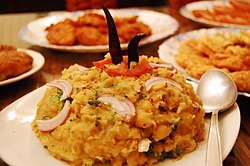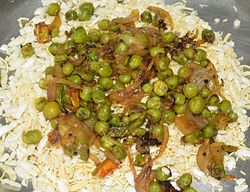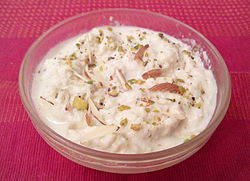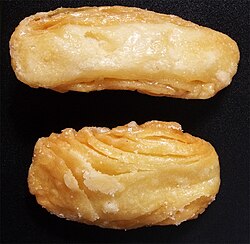| This article is part of the series on |
| Indian cuisine |
|---|
 |
Bihari cuisine is eaten mainly in the eastern Indian state of Bihar, as well as in the places where people originating from the state of Bihar have settled: Eastern Uttar Pradesh, Bangladesh, Nepal, Mauritius, South Africa, Fiji, some cities of Pakistan, Guyana, Trinidad and Tobago, Suriname, Jamaica, and the Caribbean. Bihari cuisine includes Angika cuisine, Bhojpuri cuisine, [1] Maithil cuisine and Magahi cuisine.
Contents
- Bihari thali
- Traditional cuisine
- Regional
- Appetizers
- Breads
- Vegetarian cuisine
- Saags
- Non-vegetarian cuisine
- Snacks
- Sweets
- See also
- References
The cuisine of Bihar is largely similar to North Indian cuisine and East Indian cuisines. It is highly seasonal; watery foods such as watermelon and sharbat made from the pulp of the wood-apple fruit are consumed mainly in the summer months, while dry foods such as preparations made of sesame seeds and poppy seeds are consumed more frequently in the winter months.
Bihari cuisine include litti chokha , [2] a baked salted wheat-flour cake filled with sattu (baked chickpea flour) and some special spices, which is served with baigan bharta, [3] made of roasted eggplant (brinjal) and tomatoes. [4] [5] Dairy products are consumed frequently throughout the year, including dahi (yogurt), spiced buttermilk (known as mattha), ghee, lassi and butter.
There are numerous Bihari meat dishes, with chicken and mutton being the most common. Fish dishes are especially common in the Mithila region of North Bihar due to the number of rivers, such as the Sone, Gandak, Ganges and Koshi. Among meat dishes, meat saalan [6] is a popular dish made of mutton or goat curry with cubed potatoes in garam masala . Dalpuri is another popular dish in Bihar. It is salted wheat-flour bread, filled with boiled, crushed, and fried gram pulses. [7]
Malpua is a popular sweet dish of Bihar, prepared by a mixture of maida , milk, bananas, cashew nuts, peanuts, raisins, sugar, water, and green cardamom. Another notable sweet dish of Bihar is balushahi , which is prepared by a specially treated combination of maida and sugar along with ghee, and the well-known sweet khaja is made from flour, vegetable fat, and sugar. Silao near Nalanda is famous for its production. During the festival of Chhath, thekua , [8] a sweet dish made of ghee, jaggery, and whole-meal flour, flavoured with aniseed, is made. [4]



























